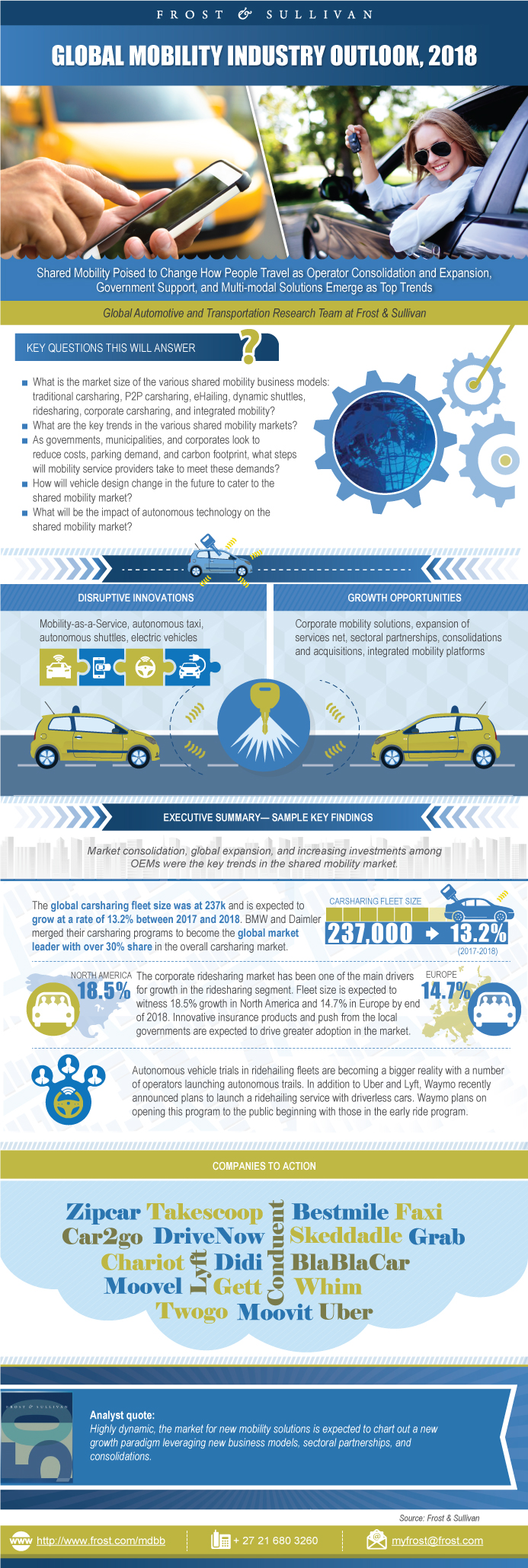Global Mobility Industry Outlook, 2018
Global Mobility Industry Outlook, 2018
Shared Mobility Poised to Change How People Travel as Operator Consolidation and Expansion, Government Support, and Multi-modal Solutions Emerge as Top Trends
23-Apr-2018
North America
$4,950.00
Special Price $3,712.50 save 25 %
Description
This research service analyzes the global mobility market and offers a 2018 outlook. The study delves into the evolving business models in the shared mobility space, market consolidations and partnerships, regulatory reforms, and advanced technology trends. Readers who will benefit from this analysis include automotive value chain participants such as mobility service providers, OEMs, car rental and leasing companies, financial service providers, technology solution providers, and a host of other industry participants looking to understand current mobility market trends and their implications. Market analysis covers 2015 through 2018.
The study looks at 7 collaborative business models—carsharing, peer-to-peer (P2P) carsharing, corporate carsharing, eHailing, ridesharing, dynamic shuttle/demand responsive transit (DRT), and integrated mobility. One of the primary reasons for the growing popularity of these business models is that they help combat pressing issues such as congestion and pollution, which many cities across the globe are battling.
The key metrics discussed cover mobility participants and the vehicles involved with each applicable business model. The mobility market will see a lot of activity in terms of investments/mergers and acquisitions among the various stakeholders. Automakers will be among the most important stakeholders as they are exploring alternative streams of revenue from the mobility market. There is significant room for innovation in the shared mobility space, for both mobility operators and technology software providers who can keep updating their offerings to provide a more holistic customer experience.
Geographic Scope: For the carsharing, P2P carsharing, corporate carsharing, dynamic shuttle, integrated mobility, and eHailing market segments, the geographic scope covered is global while for ridesharing the scope is North America and Europe.
Key Issues Addressed
- What is the market size of the various shared mobility business models: traditional carsharing, P2P carsharing, eHailing, dynamic shuttles, ridesharing, corporate carsharing, and integrated mobility?
- What are the key trends in the various shared mobility markets?
- How will vehicle design change in the future to cater to the shared mobility market?
- As governments, municipalities, and corporates are looking to reduce costs, parking demand, and carbon footprint, what steps will mobility service providers take to meet these demands?
- What are the upcoming technology solutions influencing mobility market trends? How will existing service providers adapt to the shift in technology trends?
- What will be the impact of autonomous technology on the shared mobility market?
- Which OEMs are partnered with key global mobility service providers? Will the entry of more OEMs affect the growth of existing market participants?
RESEARCH: INFOGRAPHIC
This infographic presents a brief overview of the research, and highlights the key topics discussed in it.Click image to view it in full size

Table of Contents
Key Findings—Highlights 2017
Key Findings—2018 Outlook
Significant Growth Expected in the Mobility Market
Global Expansion to Drive Market Growth
Future Vehicle Concepts—Demand Responsive Transit (DRT) and Ridesharing
Future Vehicle Concepts—DRT and Ridesharing (continued)
Autonomous Vehicles in Mobility
Research Scope
Key Questions this Study will Answer
Research Background
Research Methodology
Traditional Carsharing
Traditional Carsharing—Global Membership and Fleet Size
Traditional Carsharing—Key 2017 Highlights and 2018 Outlook
P2P Carsharing
P2P Carsharing Market—Overview
P2P Carsharing—Key 2017 Highlights and 2018 Outlook
Corporate Carsharing
Corporate Carsharing (continued)
Definition of Ridesharing Types
Ridesharing Industry Overview—Europe and North America
Ridesharing—Key 2017 Highlights and 2018 Outlook
Definition of eHailing Business Models
eHailing—Connected Vehicles and Revenue
eHailing—Key 2017 Highlights and 2018 Outlook
The Concept of Demand Responsive Transit (DRT)
Demand Responsive Transit—Industry Overview
Demand Responsive Transit—Key 2017 Highlights and 2018 Outlook
Integrated Mobility Landscape
Mobility-as-a-Service—Key Partnerships and Investments
OEMs’ Shift towards CaaS—Futureproof Business
Growth Opportunity—Mobility Business Models
Strategic Imperatives for Success and Growth
Key Conclusions and Future Outlook
The Last Word—3 Big Predictions
Legal Disclaimer
Abbreviations and Acronyms Used
List of Exhibits
List of Exhibits (continued)
List of Exhibits (continued)
Popular Topics
Key Issues Addressed
- What is the market si
| No Index | No |
|---|---|
| Podcast | No |
| Author | Albert Geraldine Priya |
| Industries | Automotive |
| WIP Number | MDBB-01-00-00-00 |
| Keyword 1 | Mobility |
| Is Prebook | No |
| GPS Codes | 9673-A6,9800-A6,9807-A6,9813-A6,9965-A6,9A57-A6,9AF6-A6,9B07-C1,9B15-A6 |
 USD
USD GBP
GBP CNY
CNY EUR
EUR INR
INR JPY
JPY MYR
MYR ZAR
ZAR KRW
KRW THB
THB